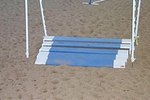Things You'll Need
Tape measure
Angle iron (1-1/2 in.)
Metal band saw, chop saw, or acetylene cutting torch
Angle grinder
Welder (wire-feed or stick type)
Treated boards (2 in. thick)
Miter saw or circular saw
Wire fence (4-in. gaps, 4-ft.-tall sections)
Bolt cutters
A hog on the loose can be a fearsome sight. Pigs -- as anyone who has ever tried to catch one knows -- are emphatically not slow. As such, it is important to keep your hogs under control and moving where you want them to go, not where they want to go. One of the crucial times in moving swine is loading and unloading them from a trailer. If the ramp you use to get the pigs in and out is too steep, they won't travel up it. Using angle iron and treated wood, you can make a hog ramp that will keep your pigs going in the right direction for years.
Measure the height of your stock trailer and the dimension of the doors. Your ramp will need to come up to the level of the floor of the stock trailer.
Calculate the distance of your hog ramp. Divide the height by 3 -- this will give you the number of feet the ramp ought to extend from the trailer (For a 6-in. trailer height, your ramp will be 2 feet long, for a 12-in. height, 4 feet long, etc). Multiply this figure by 1.04 to attain an angle of approximately 15 degrees for your hog ramp. 15 degrees may seem shallow, but it is best to have a shallow angle -- domestic hogs don't like steep ramps.
Cut two pieces of angle iron to the final length attained above. Cut two more pieces to the width of your trailer doors. Weld them all together to form a rectangle such that the profile of the angle iron is like an "L" with one side facing the ground, and extending toward the interior of the rectangle.
Cut and weld legs to your ramp. Cut the legs such that each set will extend 4 ft. above the surface of the ramp. Attach the set of legs at the top end of the ramp first by blocking it up the correct height above the ground, placing the legs on the ground and checking for plumb with a level, then welding them in place. Repeat the procedure for each set of legs. At the bottom of the ramp, weld two upright pieces of angle iron in place and attach a brace from it to the next set of legs with another piece of angle iron.
Cut treated lumber in pieces the width of the ramp and lay it in place. Make sure the boards fit loosely to allow for swelling and contraction with heat and cold.
Position a section of fence on the inside of the legs so that it overlaps each end of the ramp and is flush with the decking of the ramp. Tack weld it in place at multiple points, then trim the ends with a bolt cutter or acetylene torch. Repeat on the other side.
Tips
You may want to integrate a level portion of ramp to allow your trailer doors to open and close above the ramp. Build a platform in a similar manner to that described above, but without legs that extend above the decking of the ramp. Build the platform to the width of your trailer doors. That way, when you open the doors and tie them to the upright legs of the ramp, they form part of the fence that directs the hogs onto the trailer. When the hogs are loaded, simply unfasten and close the trailer doors.
References
Photo Credits
-
pig image by pearlguy from Fotolia.com
Writer Bio
Daniel Sutherland has been writing internal reports for his employers since 2005. He has extensive experience in automotive repair and do-it-yourself projects and writes on these topics for various websites. Sutherland received a Bachelor of Arts in philosophy and religion from College of the Ozarks in 2007.





